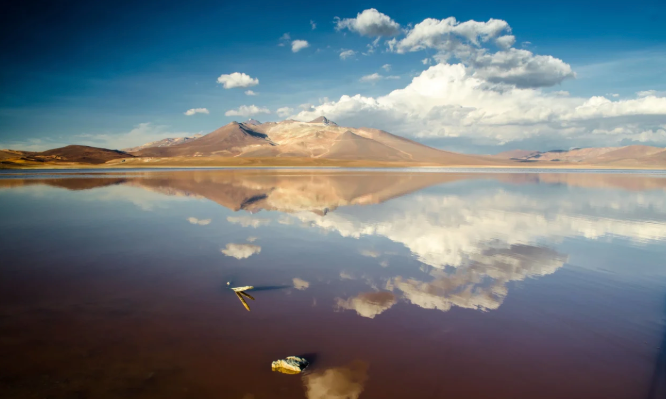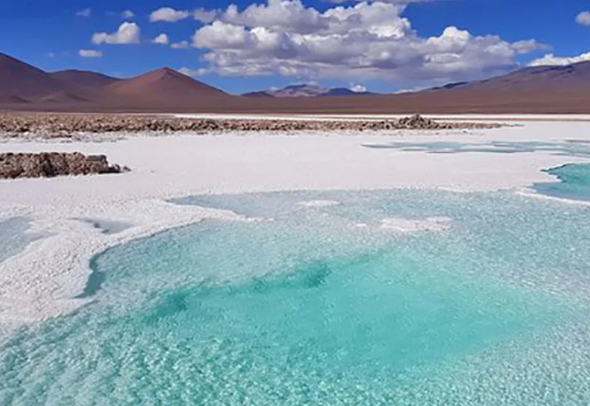Nevado Tres Cruces National Park is one of those places that reconnect you with nature. Located in the heart of Atacama Region, this park is a treasure of turquoise lagoons, endless salt flats, and monumental volcanoes towering over 6,000 meters.
When I visited Nevado Tres Cruces, I experienced one of those days that seem endless but leave an indelible mark. It’s a place where the silence and epic scale of the Andes make you feel tiny, yet part of something much greater.
Where Nevado Tres Cruces National Park is and How to Get There
The park is about 160 km northeast of Copiapó, in the Atacama Region, at over 3,700 meters above sea level. The most common route is via International Route CH-31 towards Paso San Francisco, crossing desert and mountainous landscapes of breathtaking beauty.
I traveled with a guided tour from Copiapó. Our guide knew the area inside out: geology, wildlife, and even local history. He explained how the body reacts to high altitude and how to enjoy the journey without suffering from soroche (altitude sickness). That attention made a huge difference from the first kilometer.
A Landscape of Volcanoes, Salt Flats, and High-Andean Lagoons
The park takes its name from the Nevado Tres Cruces massif, home to two of Chile’s highest peaks: Tres Cruces Sur (6,747 m) and Tres Cruces Centro (6,206 m). These giants dominate a landscape full of contrasts: white salt flats, emerald lagoons, and the deep blue of the Atacama sky.
Among its natural gems are Laguna Santa Rosa and Laguna Verde, separated by the imposing Salar de Maricunga. I vividly remember the first time I saw Santa Rosa: its waters mirrored the mountains perfectly, while flamingos moved calmly, unaware of our awe.
Flora and Fauna of Nevado Tres Cruces: Life at High Altitude
Despite the extreme climate, the park is a vital refuge for Andean species. You can spot Andean flamingos, vicuñas, guanacos, culpeo foxes, and birds like the condor.
During my visit, we paused to watch a flock of flamingos at Laguna Santa Rosa. Our guide, passionate about conservation, explained how these birds migrate and breed in high-Andean wetlands. That mix of knowledge and respect for the environment gave the experience a deeper dimension.
What to See and Do: Trails, Viewpoints, and Must-Visit Lagoons
Nevado Tres Cruces isn’t just for admiring—it’s a destination for active exploration.
Recommended activities include:
- Walking around Laguna Santa Rosa and birdwatching.
- Trekking near Salar de Pedernales, a nearly lunar landscape.
- Bathing in natural hot springs at Laguna Verde.
- Photography routes capturing spectacular Andean sunrises.
My favorite moment was when our host—a mountain enthusiast and excellent cook—prepared a lunch with snacks that, as he said, “tasted like the Andes.” He was right. It was a delicious pause with Los Jaivas playing softly in the background while the Andean wind blew gently.
Tips to Visit Without Altitude Sickness or Issues
- Acclimate: spend at least one night in Copiapó before ascending.
- Stay hydrated and avoid heavy meals the day before.
- Dress in layers: the weather can change from intense sun to extreme cold.
- Bring sunscreen and polarized sunglasses: UV levels are very high.
- Fuel and supplies: there are no services inside the park.
Thanks to our guide’s advice, we enjoyed the park without dizziness or fatigue, even above 4,000 meters.
Best Time to Visit and Weather
The ideal season is October to April, when temperatures are milder and roads are accessible. In winter (June–August), the park may have snow and restricted access.
The climate is dry and windy, with large temperature swings. Daytime can exceed 20°C, but nights easily drop below zero.
Where to Stay and What to Bring
Most visitors stay in Copiapó or nearby refuges near Laguna Santa Rosa and Laguna Verde. If camping, bring a high-mountain tent, sleeping bag, and non-perishable food.
It’s also crucial to carry GPS or downloaded maps, as cellphone signals are intermittent. If taking a guided tour, ensure the operator has CONAF permission.
Conservation, History, and Significance of the Park
Established in 1994, Nevado Tres Cruces National Park protects over 59,000 hectares of high-Andean ecosystems. It’s part of the Laguna del Negro Francisco and Laguna Santa Rosa Biosphere Reserve (UNESCO).
The park plays a key role in conserving endangered species and maintaining the hydrological balance of the area. It also preserves ancient human interactions with the mountains, including archaeological sites related to pasturing and indigenous ceremonies.
Authentic Experiences: Connecting with Nature and Local Culture
Beyond the landscapes, what makes Nevado Tres Cruces special is human connection. I remember our guide not only showing us places but also sharing his passion for conservation, culinary skills, and warmth. Thanks to him, the trip blended discovery, music, and camaraderie in an unforgettable way.
It was, without a doubt, a magical experience, one that makes you understand why Chile is considered a natural sanctuary at the end of the world.
| Attraction | Highlights / What to See & Do |
|---|---|
| Vallecito | Scenic valley with dramatic Andean landscapes, perfect for photography and short hikes. |
| Laguna Santa Rosa | Home to Andean flamingos; ideal for birdwatching and enjoying the mirror-like reflections of the surrounding mountains. |
| Salar de Maricunga | Expansive salt flat offering unique, almost lunar landscapes; great for trekking and panoramic photos. |
| Volcán Ojos del Salado | Views of the world’s highest active volcano (6,893 m); spectacular backdrop for hiking and landscape photography. |
| Laguna Verde & Nearby Hot Springs | Relax in natural hot springs at the edge of the lagoon; enjoy the tranquility and stunning Andean scenery. |
Frequently Asked Questions
Do I need a permit to enter?
Yes, you must register at CONAF checkpoints. Entry is usually free, but camping may require authorization.
Are there services or stores inside the park?
No. You must bring everything from Copiapó or El Salvador.
Can I visit independently?
Yes, but a guide is recommended for safety and to make the most of the experience.





